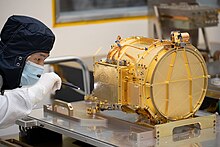Surface Dust Analyser
 | |
| Operator | NASA |
|---|---|
| Manufacturer | University of Colorado Boulder |
| Instrument type | Time-of-flight mass spectrometer |
| Function | Mapping surface composition |
| Mission duration | Cruise: 3-6 years Science phase: ≥ 3 years |
| Properties | |
| Mass | 5 kg (11 lb) |
| Dimensions | 26.8 × 25.0 × 17.1 cm3 |
| Host spacecraft | |
| Spacecraft | Europa Clipper |
| Operator | NASA |
| Launch date | ≈ 2025[1] |
| Rocket | Falcon Heavy |
| Launch site | Kennedy Space Center |
TheSUrface Dust Analyser(SUDA) is atime-of-flight mass spectrometerofreflectron-typethat employsimpact ionizationand is optimised for a high mass resolution.[2][3]The instrument was selected in May 2015 to fly on board theEuropa Clippermission, that is planned for 2025[1]toJupiter's moonEuropa.
This instrument will measure the composition of small, solid particles ejected from Europa, providing the opportunity to directly sample the surface and potential plumes on low-altitude flybys. Europa's internal liquid water ocean has been identified as one of the locations in the Solar System that may offer habitable environments to microbialextraterrestrial life.[4][5][6]
Overview
[edit]
The basic idea of compositional mapping is that moons without an atmosphere are surrounded by clouds of dust particles released from their surfaces by meteoroid bombardment. The ejected particles can be sampled and their composition analyzed from orbit or during a spacecraftflyby.[3]Since these grains are direct samples from the moons' icy surfaces, determination of their composition will help to define and constrain the geological activities on and below the moons' surface, the exchange processes with the deeper interior, and assess its internal oceanhabitability potential.[3][7]The instrument is capable of identifying traces oforganicand inorganic compounds in the ice of ejecta.[8]
The SUDA instrument has technological heritage from theCassiniCDAand theStardustCIDAinstruments.[3]The Principal Investigator is Sascha Kempf, from theUniversity of Colorado Boulder.Co-investigators on the instrument include Mihaly Horanyi and Zoltan Sternovsky.
| Parameter | Units/performance[3] |
|---|---|
| Mass | 5 kg (11 lb) |
| Dimensions | 26.8 × 25.0 × 17.1 cm3 |
| Sensitive area | 220 cm2 |
| Effective mass resolution | 200 to 250 m/Δm |
| Mass range of interest | 1-250amu |
Scientists expect SUDA to be able to detect a single cell in an ice grain.[9]
Objectives
[edit]The SUDA objectives are:[10]
- Provide a spatially resolved compositional map of Europa for the regions along the groundtracks of the orbiter's flybys.
- Characterize the alteration of Europa's surface via exogenous dust impacts by measuring the composition, size, speed, and spatial distribution of dust in the vicinity of the moon.
- Investigate the local plasma environment of Europa by measuring theelectrostatic chargeof dust particles in the vicinity of the moon.
References
[edit]- ^abEuropa Clipper passes key review.Jeff Foust,Space News.22 August 2019.
- ^SUrface Dust Mass Analyzer (SUDA) selected for Europa mission.Sascha Kempf,Phys Org.May 27, 2015.
- ^abcdeSUDA: A Dust Mass Spectrometer for Compositional Surface Mapping for a Mission to Europa(PDF). S. Kempf, N. Altobelli, C. Briois, E. Grün, M. Horanyi, F. Postberg, J. Schmidt, R. Srama, Z. Sternovsky, G. Tobie, and M. Zolotov.EPSC AbstractsVol. 9, EPSC2014-229, 2014. European Planetary Science Congress 2014.
- ^Dreier, Casey (12 December 2013)."Europa: No Longer a" Should, "But a" Must "".The Planetary Society.
- ^Schulze-Makuch, Dirk; Irwin, Louis N. (2001)."Alternative Energy Sources Could Support Life on Europa"(PDF).Departments of Geological and Biological Sciences.University of Texas at El Paso.Archived fromthe original(PDF)on 2006-07-03.
- ^Zabarenko, Deborah (7 March 2011)."Lean U.S. missions to Mars, Jupiter moon recommended".Reuters.
- ^SUDA: a dust mass spectrometer for compositional surface mapping for the JUICE mission to the Galilean moons(PDF). S. Kempf, C. Briois, H. Cottin, C. Engrand, E. Grün, K. Hand, H. Henkel, M. Horányi, M. Lankton, J.-P. Lebreton, F. Postberg, J. Schmidt, R. Srama, Z. Sternovsky, R. Thissen, G. Tobie, C. Szopa, and M. Zolotov.International Workshop on Instrumentation for Planetary Missions,2012.
- ^Kempf, Sascha; et al. (May 2012). "Linear high resolution dust mass spectrometer for a mission to the Galilean satellites".Planetary and Space Science.65(1): 10–20.Bibcode:2012P&SS...65...10K.doi:10.1016/j.pss.2011.12.019.
- ^Klenner, Fabian; Bönigk, Janine; Napoleoni, Maryse; Hillier, Jon; Khawaja, Nozair; Olsson-Francis, Karen; Cable, Morgan L.; Malaska, Michael J.; Kempf, Sascha; Abel, Bernd; Postberg, Frank (2024)."How to identify cell material in a single ice grain emitted from Enceladus or Europa".Science Advances.10(12): eadl0849.doi:10.1126/sciadv.adl0849.PMC10959401.PMID38517965.
- ^Quick Facts: Europa SUrface Dust Mass Analyzer (SUDA)Archived2022-06-19 at theWayback Machine.University of Colorado Boulder, 2017.


